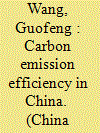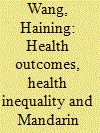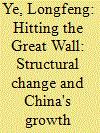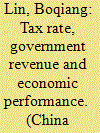|
|
|
Sort Order |
|
|
|
Items / Page
|
|
|
|
|
|
|
| Srl | Item |
| 1 |
ID:
168361


|
|
|
|
|
| Summary/Abstract |
Distortions in the capital market are notable in developing economies like China. By building up a dual production structure with oligopolistic competition in urban manufacturing, this paper investigates the distributional and welfare effects of capital market distortions. We find that in the short run, an increase in the capital market distortion in favor of urban firms can lower both the skilled and unskilled wages. However, in the long run, the preferential policy on reducing capital cost to the urban sector attracts new entry of firms, which can worsen the skilled-unskilled wage inequality in the economy. This firm-entry effect of the capital market distortion on wage inequality is empirically confirmed for China.
|
|
|
|
|
|
|
|
|
|
|
|
|
|
|
|
| 2 |
ID:
168364


|
|
|
|
|
| Summary/Abstract |
Regional cooperation has become a new direction for China development. Indeed, carbon emission reduction is especially important to combat Climate change. In this paper, we use Direction Distance Function to estimate the overall carbon emission efficiency. We empirically estimate the spatial Moran'I and LISA cluster in China from 2005 to 2016. Our results show carbon emission efficiency presents the spatial pattern of gradually decreasing in “Eastern, Central, Western” and symmetrical distribution in “Southern, Central, Northern” of China. High efficiency spatial cluster areas mainly concentrate on the mid-east coastal provinces, which technical level and policies are better than those of the inland among the factors influencing carbo emission efficiency, energy structure, technology and urbanization have a significant impact. This paper will provide some scientific support to solve cooperation between province to combat carbon emission.
|
|
|
|
|
|
|
|
|
|
|
|
|
|
|
|
| 3 |
ID:
168363


|
|
|
|
|
| Summary/Abstract |
In this experimental study, we investigate whether when subjects in Beijing, China, have the opportunity to contribute to a global public good, their behavior is conditionally cooperative. For this purpose, participants were offered the opportunity to contribute to climate change mitigation by purchasing permits from the Beijing carbon dioxide (CO2) emissions trading scheme (ETS). The purchased permits were then withdrawn from the ETS. Here, individual behavior is controlled by means of the strategy method. In this study, we observed different types of behavior, including conditionally cooperative behavior. Overall, the probability of contributing to CO2 emissions reduction is higher if the subjects considering contributing to CO2 emissions reduction can assume that a two-thirds majority of all the other subjects are also willing to do so, compared to a situation where only up to one-third of all the other participants decide to contribute to this scheme.
|
|
|
|
|
|
|
|
|
|
|
|
|
|
|
|
| 4 |
ID:
168354


|
|
|
|
|
| Summary/Abstract |
The actual energy savings from efficiency improvement may be less than expectations because of behavior response of micro-units, which is named as rebound effect. For producers, the magnitude of such response depends on the operating flexibility. However, the precise; role of operating flexibility in rebound effect is still unknown because of difficulties in measuring operating flexibility. Over the past four decades, the Chinese government has implemented a wide range of reforms aiming at market-oriented transition, which increase operating flexibility of micro-units. It is natural to be questioned whether China's market-oriented reform increases energy rebound effect. In this study, we aim to explore the impacts of marketization on rebound effect. Using partially linear functional-coefficient panel data model to avoid prior criteria in model specification and smooth the change of rebound effect across regions, we found that about 20% of originally expected energy conservation from energy efficiency improvement would be rebounded in 2013. Furthermore, the results demonstrate that in line with China's uneven reform across regions, coastal provinces such as Jiangsu, Zhejiang, Tianjin, Shanghai, Beijing, and Guangdong, have larger rebound effects, which may be connected with their larger operating flexibility. The findings can enhance our understanding on the mechanisms of rebound effect as behavior responses. We also anticipate our paper to provide knowledge and broader implications toward optimal policy designs alongside China's ongoing market-oriented reforms.
|
|
|
|
|
|
|
|
|
|
|
|
|
|
|
|
| 5 |
ID:
168356


|
|
|
|
|
| Summary/Abstract |
This paper studies how economic policy uncertainty affects corporate tax burden. We show that economic policy uncertainty is positively related to corporate tax burden, and the effect is stronger when the tax quotas are higher. Furthermore, we find that economic policy uncertainty strengthens tax collection by increasing government fiscal pressure, thereby increasing corporate tax burden. Besides, the effects of economic policy uncertainty on corporate tax burden are primarily significant in state-owned enterprises (SOEs), non-high-tech firms, firms from the eastern areas and service industry firms. The evidence illustrates that keeping the transparency and stability of economic policies helps to cut tax burden effectively.
|
|
|
|
|
|
|
|
|
|
|
|
|
|
|
|
| 6 |
ID:
168358


|
|
|
|
|
| Summary/Abstract |
The proposed income distribution effect of financial liberalization has gradually attracted the attention of academic economists, but the research results are inconsistent and even contradictory. This paper presents a quantitative review of these studies. The objectives are to assess the impact of financial liberalization on income inequality and to identify the sources of heterogeneity. A meta-analysis is performed with 23 empirical cross-country studies on the relationship between financial liberalization and income inequality, yielding a total of 556 estimates. We find overall support for the small negative relationship between financial liberalization and income inequality when considering potential publication bias and method heterogeneity. Our results suggest that different impact channels, institutional quality, the measurement used for financial liberalization and income inequality, and the use of different econometric methods are especially effective for explaining the differences in past study findings.
|
|
|
|
|
|
|
|
|
|
|
|
|
|
|
|
| 7 |
ID:
168355


|
|
|
|
|
| Summary/Abstract |
We examine the health returns to proficiency in Mandarin in urban China using longitudinal data from the China Family Panel Studies. We find that greater proficiency in Mandarin improves self-reported health, mental health and capacity to perform activities of daily living. We also examine the relationship between Mandarin proficiency and health inequality and the decomposition results show that differences in Mandarin proficiency account for between 2% and 20% of health inequality in urban China, depending on the health indicator. Our results suggest that promoting ‘standard Mandarin’ can serve as a vehicle to improve health outcomes and reduce health inequality.
|
|
|
|
|
|
|
|
|
|
|
|
|
|
|
|
| 8 |
ID:
168357


|
|
|
|
|
| Summary/Abstract |
China is facing slowing growth rates, slowing rates of rural to urban migration and resistance to reforms that would liberalize internal migration restrictions (Hukou). We use a two sector Ramsey growth model and show that, allowing for endogenous capital accumulation, labour reallocation has accounted for approximately one fifth of China's per capita GDP growth over the last 30 years, and that Hukou reform could generate a significant boost to China's per capita GDP growth over the next decade. Our results contrast with conclusions drawn from the traditional growth accounting literature on labour reallocation effects in China because our simulation method allows for endogenous capital accumulation dynamics.
|
|
|
|
|
|
|
|
|
|
|
|
|
|
|
|
| 9 |
ID:
168359


|
|
|
|
|
| Summary/Abstract |
As the residential sector is becoming increasingly important in the total energy consumption and appliance ownership is a significant but under-examined driver, this study investigates the relationship between income inequality and appliance ownership using panel data from the China Health and Nutrition Survey (CHNS). We find that income inequality has negative impacts on appliance penetration rate across specifications, except for the initial development stage. On average, households start adopting air conditioners at a threshold of over 60,000 (2011 RMB) based on annual income, much higher than TV, fridge and washer (8500–9000 RMB). The empirical results validate the S-shape curve of appliance established in the literature. To understand the magnitude of the impact and policy implications, we further simulate the impact of poverty alleviation and the penetration paths under inclusive versus exclusive income growth. Our results demonstrate that current poverty line is too low to achieve appliance adoption – a signal for modern life-styles. In addition, a more inclusive growth path could lead to much higher penetration for regions that have relatively low growth rate.
|
|
|
|
|
|
|
|
|
|
|
|
|
|
|
|
| 10 |
ID:
168360


|
|
|
|
|
| Summary/Abstract |
This paper studies how the fixed exchange rate regime (FERR) may promote growth when a country experiences faster rates of productivity growth in its tradable sector than its nontradable sector. In a simple two-sector model with money, we show that the FERR can reduce the Balassa-Samuelson effect if wage adjustment is subject to nominal rigidities. The undervaluation thus created suppresses real wage growth but increases the size of the tradable sector and leads to higher growth rates of the entire economy. Using cross-country panel data, our econometric exercises provide robust evidence that supports the results. Meanwhile, other fundamentals, including the external balance position, export share in the tradable sector, and the stage of development, play roles in determining the effects of FERR. Last, we apply the empirical results to run simulations on China from 1994 to 2007 to highlight the role of FERR in the country's export-led growth.
|
|
|
|
|
|
|
|
|
|
|
|
|
|
|
|
| 11 |
ID:
168362


|
|
|
|
|
| Summary/Abstract |
The Laffer curve illustrates a theoretical relationship between rates of taxation and the resulting levels of government revenue. This paper explores the relationship between tax rate (direct tax on labor income), government revenue and economic performance in a perspective of the Laffer curve by applying Computable General Equilibrium (CGE) model. The results show that the top of China's Laffer curve is about 40%. The government should consider changes in the entire taxation system and not just changes in direct taxes while increasing direct tax rate. If China wants to maximize tax revenues, the direct tax rate should be 35%. We conduct a variety of sensitivity analyses and conclude that the government tax peak is always 5–10% earlier than the apex of the Laffer curve. So, if a country has reached the top of the Laffer curve, this paper strongly recommends that tax cuts will have positive implications for the economy and government revenue.
|
|
|
|
|
|
|
|
|
|
|
|
|
|
|
|
|
|
|
|
|